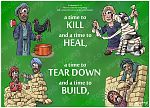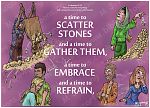Bible Cartoon: Ecclesiastes 03 - A time for everything - Scene 03 - Weep, laugh, mourn, dance
Click on Add to cart button below shopping cart.
Purchased Bible Cartoons do not have watermarks. Links to Cartoons provided on email once purchase is completed.Bible Book: Ecclesiastes
Bible Book Code: 2100300401
Scene no: 3 of 7
Bible Reference & Cartoon Description
Ecclesiastes 3:1,4 (ANIV)
1 There is a time for everything, and a season for every activity under heaven:
4 a time to weep and a time to laugh, a time to mourn and a time to dance, …
DRAWING NOTES:
TIME OF DAY:
LIGHTING NOTES:
CHARACTERS PRESENT:
RESEARCH/ADDITIONAL NOTES:
I have decided to include verse 1 in all the following 7 “A time for everything” scenes & articles notes, to remind the viewer of the point of the list (verses 2-8).
The teacher (king Solomon) refers here (verse 1-8) to every activity under heaven, meaning everything that we human beings get up to. Our achievements, our follies, our actions, our lack of actions, our moods & attitudes. Of course this is not a comprehensive list of ALL human activity, but I think it is indicative of the major headings of human activity.
By looking at other versions of the Bible we can get a more complete understanding of what the teacher was writing about. Verse 1 in the Amplified Bible refers to “every matter or purpose under heaven”. In the Message version “a right time for everything on the earth” is referred to, whilst the Bible in Basic English calls it “every business under the sun”. The English Standard Version refers to it as “every matter under heaven”.
The Hebrew word for “activity,” (chephets (transliteration); pronounced khā‘·fets) always used of people, literally means “delight”, “desire”, “longing”, “the good pleasure” &/or “that in which one takes delight”. The word also refers to willing participation &/or acceptable purpose.
In relation to all of these various human activities the teachers states (in verse 17 of the same chapter):
17 I said to myself, “In due season God will judge everyone, both good and bad, for all their deeds.”
Notice it says ALL their deeds, not merely some of them. It refers to all deeds we willingly participate in.
The teacher followed his general statement (”There is a time for everything…”) with a poem composed of 7 pairs (14 in total) of polar opposites. It is interesting that king Solomon used 7 pairs of polar opposites (the poetical device called merism), since the number 7 suggests the idea of completeness or totality in Hebrew literature. Solomon begins his poem with “birth & death” and ends it with “war & peace”, with all the other human activities in between these grandest & gravest of themes.
Weap, Laugh, Mourn, Dance.
Now to the particulars: verse 4 – “a time to weep and a time to laugh, a time to mourn and a time to dance, …” the polar opposites in this verse are weeping (or crying) & laughing, mourning & dancing.
As I pointed out in the previous scene’s notes this poem begins in reference to birth (the beginning of a person’s physical life) and death (the end of a person’s physical life), & in the next verse this concept of beginning & ending is further elaborated in reference to killing & healing.
King Solomon seems to have now turned his attention to writing about human reactions to this start & end of life; to birth & health, versus killing & death. Normally birth, or the beginning of life, would be an occasion for celebration. The birth of a baby is usually greeted with happiness & joy, even laughter. This condition is what Solomon may have been referring to in his duel statements “a time to laugh” & “a time to dance”. We get the sense of celebration in that choice of words.
The polar opposite is included in the duel phrases “a time to weep” & “a time to mourn”. The usual human response as people approach their death is sadness & tears; weeping & mourning or grieving, either on the part of the person dying, or else on the part of those nearest & dearest to them.
So it may be that King Solomon’s poem is reflecting on the various emotional states that we encounter in response to birth (laughing, happiness & dancing) & death (mourning, grieving & tears).






